Abstract
Rapid urbanization and climate change are the driving forces behind changing the urban landscape and affecting natural resources and the environment, particularly in the megacities of arid regions. Many of these cities face an acute water crisis leading to over-exploitation of groundwater resources. This over-exploitation has led to the depletion of aquifers, land infertility, saline intrusion, land subsidence, and harm to hydrological ecosystems. Globally, numerous studies have documented the potential of groundwater recharge (GWR) using GIS and remote sensing techniques. However, its practical application in a landscape context for sustainable urban and regional development is underexplored. In this study, we developed the landscape-based GWR concept by conducting a case study of Karachi city (Pakistan). We took physical landscape (surface and sub-surface) features and groundwater recharge potential as a base for design and planning to improve groundwater recharge and urban landscape. Moreover, we highlighted the added values of this approach besides recharging the depleted ground hydrological conditions and improving the urban landscape condition (i.e., social–ecological inclusiveness, sustainable future development, and interdisciplinary collaboration). The results indicated a negative impact of urbanization on groundwater recharge, especially in the alluvial zones and river valleys, underscoring the need for a spatial approach to safeguard GWR and guide development. Through this study, we propose that landscape-based GWR can be one of the potential solutions not only for the critical water crisis faced by rapidly urbanizing arid megacities but also for improving the overall quality of life and urban landscape. Furthermore, this holistic approach toward groundwater recharge can guide future urban development patterns, preservation of high groundwater recharge potential sites, and evolution toward sustainable development in arid regions where groundwater is the most significant yet vulnerable resource.
1. Introduction
Though groundwater is essential globally, it is one of the most precarious resources, especially in arid regions [1,2]. Many arid regions face uncontrolled urbanization, rising global temperatures, unpredictable climate change, and unrestricted groundwater abstraction [2,3,4]. These regions suffer significantly from the wicked urban water crisis, continuously degrading water resources (especially groundwater), increased ecological footprint, and unmanaged and crippled quality of urban life [5]. The short-term and rigid engineering-focused solutions to these interlinked urban challenges have disconnected land use from hydrological logic. These monofunctional stand-alone solutions have also failed to address the unique challenges of developing arid megacities, particularly in the Global South [6,7]. This has resulted in fragmented and sectoral practices in spatial planning, urban space, landscape, and user experience [8].
Previous research suggests that groundwater recharge (GWR) is essential for maintaining groundwater levels and ensuring long-term water security [9,10,11,12]. Various surface and subsurface landscape conditions influence GWR, including land use, vegetation, geology, and soil type. For instance, Nagesh et al. demonstrated that GWR provides essential ecosystem services besides its hydrological importance, such as reducing saltwater intrusion, enhancing biodiversity, and improving soil fertility [13]. Despite the significance of groundwater resources for sustainable development and long-term water security in the regions, they have not always been properly managed [14]. On the other hand, many landscape-based sustainability approaches have helped advance the practice of sustainability on local, regional, and global scales [15]. This nexus between GWR and spatial, social, and ecological processes aligns with using landscape as a base for design and planning, emphasizing the interconnectedness of humans and natural systems [10].
However, there are three major gaps in the systematic integration of GWR in urban and regional environments despite the strong link of GWR with sustainable development. First, the GWR literature primarily focuses on quantitative methods and results, making this knowledge very specialized, fragmented, and technical from a spatial perspective [10]. Second, there is a lack of a radical approach with a holistic framework incorporating landscape and hydrological principles for recharging groundwater resources [10,16], especially in rapid urbanizing and limited resources in arid regions such as the Global South [7]. Third, there is a gap in the practical demonstration of groundwater recharge (GWR) potential and values from a spatial perspective toward socially and ecologically inclusive sustainable development in real-world contexts [10].
The objectives of this paper are consequently threefold. First, to propose that integrating groundwater recharge strategies in spatial planning and landscape design can address immediate water security challenges, improve landscape quality, and provide ecological and social benefits that contribute to the resilience and sustainability of urban environments. For this, we developed a landscape-based groundwater recharge (Subsection of Section 1) approach based on landscape systems, GWR techniques, and spatial design thinking. Also, we explored the added value of using landscape-based GWR to develop in arid regions. Second, to identify the relationship between different landscape systems and groundwater recharge. Third, to propose an application perspective of landscape-based groundwater recharge in the context of arid regions.
Karachi city (Pakistan) serves as a case study in this paper to explore the operational methods of landscape-based groundwater recharge in a real-world context [17]. First, we analyzed the urban evolution of Karachi and its impact on water management and groundwater recharge (GWR). Second, we modified Karachi’s groundwater recharge potential mapping by adding a geomorphological map of Karachi to the analytical hierarchy process (AHP), since geomorphology is one of the most heavily weighted factors in GWR potential calculation [18]. Additionally, we developed natural and urban GWR composite maps to understand the natural GWR potential and the role of urbanization in damaging the GWR potential of Karachi city. Also, we proposed that taking GWR as the base of different spatial landscape typologies can be an application perspective of landscape-based GWR in Karachi.
In a broader context, this research can potentially inform sustainable urban development practices in arid regions worldwide by integrating landscape as the base of design and planning. The study subsequently elaborates on landscape-based GWR as a holistic solution to numerous contemporary urban challenges faced by megacities of arid regions. It translates the relationship between different systems/layers of the urban landscape and their individual and combined suitability for GWR as spatial development opportunities. Moreover, how GWR and urban landscapes can strengthen each other by simultaneously repairing urban green quality and groundwater levels is also presented in this study. Although this study also uses the conventional tools of multi-criteria analysis, weight assignment to various parameters, and AHP to develop a landscape-based GWR potential map, the focus and novelty of this study lie in its reflection on the spatial opportunities of GWR from a holistic landscape perspective.
Landscape-Based Groundwater Recharge
Groundwater recharge (GWR) is the downward flow of water reaching the water table, forming an addition to the groundwater reservoir that may be natural or managed and direct or resulting from the near-surface concentration of water without well-defined channels [19,20]. It also involves landscape modifications or infrastructure developments to enhance water infiltration into the ground during dry periods [21]. GWR is based on knowledge from geology, soil formation, physiography, and ground hydrological conditions. These aspects are also the fundamentals of any landscape, which carries many values and services and is a workable space for addressing interconnected global challenges [22,23]. Recognizing these valuable landscape services in design, planning, and decision-making, and using natural structures and processes to carry out the function, constitutes the basic principle of a landscape-based approach [23]. It encourages a better understanding of the connection between various surface and sub-surface landscape systems and humans. Also, it explores the potential suitability for different processes (i.e., groundwater recharge) in different areas [24,25]. The landscape approaches embrace a holistic philosophy and have been promoted as alternatives to conventional sectoral land use planning, policy, and management, and are strongly linked to urban sustainability and land use [26]. These approaches allow interdisciplinary knowledge creation and sharing, advocate for making policy, planning, and management more sensitive to space and scale, and provide a holistic understanding of the relationship between humans and their surrounding landscape [27]. This way, the landscape approach connects spatial planning and multiple stakeholders’ objectives. The involvement of different stakeholders allows the opportunity to explore the issues from design to management through a local lens and regional endeavor (systematic thinking) through co-creative design [23]. Specifically, landscape design can be a critical link between scientific research and practical applications [10]. Designers can connect knowledge and insight from various sectors and develop solutions to scientific problems and new problems that the solutions entail [6,28]. In this manner, landscape (physical and non-physical) can guide GWR strategies toward network formulation and long-term adaptive solutions for a sustainable urban environment.
Many water management approaches (i.e., buffer zone management, watershed management, sponge cities) offer valuable insights about groundwater recharge and its application. However, they lack (1) a focus on holistic integration of GWR, (2) flexible and adaptive application in changing conditions, (3) multifunctionality, (4) spatial planning and design perspective, and (5) future orientation of sustainable development at different scales [29,30]. As a process-oriented approach linking spatial planning, landscape, and groundwater recharge, “landscape-based groundwater recharge” provides an iterative loop for incorporating GWR into urban planning and regional development (Figure 1) [10]. Using visualization techniques like suitability mapping, scenario modeling, and design experiments, this approach helps to co-create GWR opportunities and transform urban environments through community engagement and feedback loops.

Figure 1.
An iterative loop for landscape-based GWR (Source: Riaz et al., 2025 [10]).
Landscape-based GWR can significantly help improve the urban landscape by integrating hydrological processes spatially across the landscape. This approach is based on restoring the essential relationship between green (landscape) and blue (water) to further ensure ecological, social, and economic prosperity. Hence, it takes the landscape first and considers the biosphere as the context for social and economic development, which also echoes the Sustainable Development Goals (Figure 2) [31]. This approach is socially and ecologically inclusive as it recognizes GWR as an interaction between biophysical (ecological) and anthropogenic (social) systems. Its holistic value allows the improvement of biodiversity, quality of life, fragmented urban landscape, and urban greenery while solving the core urban issues related to water, pollution, food security, and urban infrastructure.
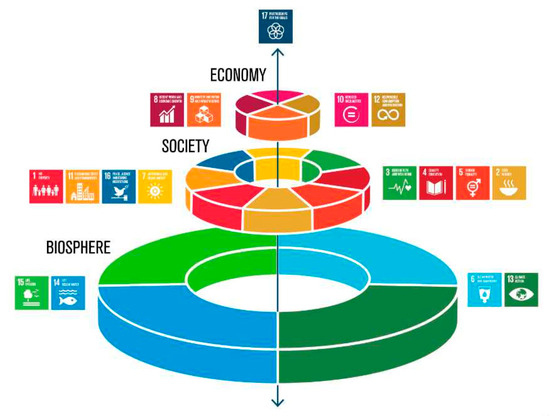
Figure 2.
Landscape as the base for social and economic development (source: Stockholm Resilience Centre).
In summary, landscape-based groundwater recharge has three conceptual components to develop area-specific strategies by understanding the contextual landscape and related social–ecological processes as the basis of spatial development, i.e., groundwater recharge techniques, landscape, and knowledge-based design (Figure 3) Groundwater recharge techniques provide a toolbox of natural or artificial recharge strategies. Landscape understanding helps to understand the logical relationship between abiotic factors (such as climate, relief, soil, and water) and biotic factors (such as vegetation, animals, and humans) in a social–ecological construct [32]. Knowledge-based design plays a role as a creative tool to generate ideas and visualize possible solutions. The design also allows spatially translating and integrating scientific knowledge from other disciplines, such as ecology, urban planning, cultural history, and water management [23]. It also provides an opportunity to visually foresee the effectiveness of strategies and generate principles.
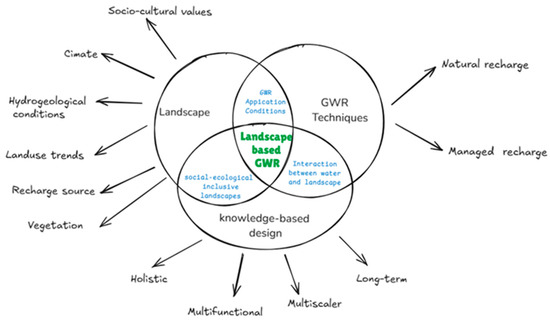
Figure 3.
GWR techniques, Landscape, and knowledge-based design as three conceptual units of landscape-based groundwater recharge.
2. Method
We used a case study of Karachi city to explore the potential application of the landscape-based groundwater recharge approach. Case-study research is one of the most widely used qualitative research methods, and it implies much more than exploring a phenomenon in a specific context [17]. It also involves studying the complex dynamics of interaction when the boundaries between phenomena within their context are not evident [33]. Our study can be classified as theory-building with an exploratory purpose [34], as it investigates the intricate relationship between landscape and groundwater recharge, and its possible spatial application strategy. Karachi potentially fits as a case to present this approach because of the critical challenges it is facing (i.e., rapid urbanization as one of the fastest growing megacities of the world, sectoral and short-term development focus, unmanaged and limited resources), the carrying capacity of landscape (ranging from ecological reserves to alluvial river valleys, agriculture, and coastal zones), and socio-cultural diversity. The methodology of this study can be divided into three phases:
- (1)
- Phase 1: Understanding and identifying the opportunities and challenges of Karachi’s natural and urban landscape. For this, we reviewed grey literature, government reports, historical archives, and development plans.
- (2)
- Phase 2: Developing a landscape-based GWR approach. We reviewed the literature on GWR techniques, landscape approaches, and water management in arid regions. To understand the landscape as a system and its interrelationship, we employed groundwater recharge potential mapping (individual landscape layers and landscape composite), leading to the development of different spatial landscape typologies and application perspectives of landscape-based groundwater for Karachi city.
- (3)
- Phase 3: Exploring the added value of landscape-based GWR in terms of social–ecological inclusiveness and as a multiscale spatial strategy. We conducted two interdisciplinary workshops in Karachi city (2023, 2024), where professionals, researchers, and academics from urban planning, architecture, landscape, social sciences, water board professionals, and geological and civil engineers participated in an academic setting to design different scenarios of landscape-based groundwater recharge. In this way, we could bridge some documentation gaps related to groundwater and understand urban landscape evolution, water management issues, and socio-cultural context from the local experts. Also, these workshops served as a validation strategy toward the approach and helped to strengthen Phases 1 and 2 (as a cyclic process, as shown in Figure 2 and Figure 4). These workshops also directed us toward the development of spatial landscape typologies and interested sites to work with (next phase of the research).
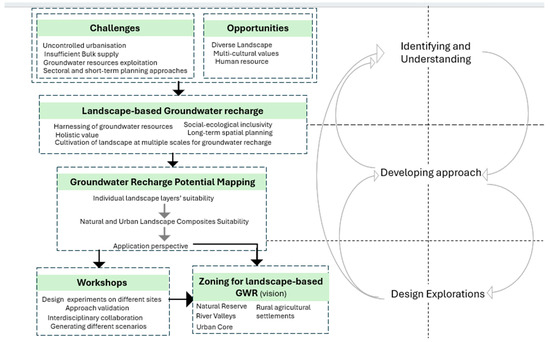 Figure 4. Methodological flow of the study.
Figure 4. Methodological flow of the study.
2.1. Case Study of Karachi City
Karachi city is the the financial powerhouse of Pakistan. It is geographically located between 24°45′ N to 25°37′ N and 66°42′ E to 67°34′ E, situated almost 128.7 km (80 miles west of the Indus River mouth, and surrounded by the Arabian Sea in the south and southwest (Figure 5) [35]. It is a multilingual city inhabited by multiple ethnic groups with distinctive cultural attributes [30,36]. According to the UNESCO Aridity Index, Karachi is an arid city with a minimal rainfall of 150–200 mm/year. This arid environment causes high surface water losses due to transpiration, seepage, and evaporation. The coastal megacity of Karachi is one of the fastest-growing megacities in the world, with an estimated population of 27.2 million in 2020 [37]. This population growth, at the fast rate of 158.2% from 1990 to 2020, has caused an increase in built-up area from 241.5 sq. km to 733.4 sq. km [37]. This transition has caused an increased abstraction of groundwater, surface runoff, soil erosion, and a decrease in infiltration and recharge opportunities [38,39,40,41,42].
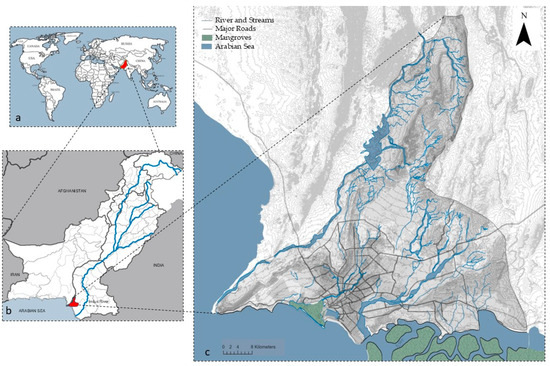
Figure 5.
(a) World map highlighting Pakistan. (b) Pakistan map highlighting Karachi in red and Indus River in blue line. (c) Karachi map with water features and infrastructure.
Like other South Asian megacities, Karachi’s water crisis also deepens daily. The city is facing its worst water crisis in history [43]. Karachi has a bulk water supply of 2.5 million m3/day (676 MGD)—nearly half of the required supply—with 35% of this water being lost during conveyance [44,45]. The unmet supply needs are compensated by privately owned tanker supplies linked to increased illegal use of hydrants and corruption in the water supply [45,46]. Also, the disparity between demand and supply has increased the demand for groundwater over the past two decades for industrial and domestic water needs [47]. Research conducted by the DAP-NEDUET University Karachi showed that groundwater is the second primary source of alternative water used by Karachi residents. This uncontrolled abstraction is causing a decline in GW level at a rate of 2–3 m per year in many areas of Karachi.
Karachi’s early “fishing village settlement” was located along the alluvial Lyari riverbed, with water-bearing strata available throughout the year [48]. Supporting services for drinking water, agriculture activities, and fishing depended upon this river, with the landscape of native fruit gardens, wells, and ponds [49]. Subsoil water was documented to be approximately 6 m higher in the higher areas and 0.6 m lower in the lowest parts of the city [48]. This cultural and functional integration of the hydrological context was later dominated by technocratic water management, which focused on pipelines and a sectoral approach from the 1800s to the present day. Our analysis shows that uncontrolled urbanization and lack of a holistic approach to water resources and future urban development strategies have adversely affected the city’s urban landscape and GW resources [35,45,48,49,50,51] (Table 1).

Table 1.
A temporal analysis of urban and water-related issues of Karachi. The red dotted line conceptualizes the decreasing trend in groundwater (Literature sources: Hasan and Mohib, 2002; Lari and Lari, 1996; Irfan et al., 2018; Pithawala et al., 1946; Qureshi, 2010; Qureshi et al., 2010 [35,45,48,49,50,51]).
The city has extended to include two more rivers within its boundary, the Hub and Malir, two non-perennial rivers that run beside the Lyari River. Construction over the natural drainage system, encroachment along the rivers, illegal sand extraction from riverbeds, and inefficient drainage and sewerage systems have increased the frequency of urban flooding in recent decades [45]. The Lyari and Malir rivers, once sources of water supply, now act as open sewage canals in the city, threatening the riparian and coastal ecosystems [52]. The sprawl analysis of Karachi shows that the built-up area is spreading rapidly in the north and east over agricultural lands. The overexploitation of aquifers has resulted in many abandoned agricultural developments, loss of biodiversity, and unemployment [37]. The cultural gardening activities (native fruit gardens) associated with rural Karachi are also declining at an alarming rate [53].
Although the river valleys have rich alluvial soils and GWR potential, sand extraction from the riverbeds, dense urbanization, and unchecked waste disposal into these rivers have altered their ecology. This has resulted in a paradoxical urban water crisis in Karachi in the form of water scarcity and unmanaged stormwater and wastewater, affecting the urban landscape conditions. The city’s urban and natural open spaces, which can be the hotspots of groundwater recharge, are under constant pressure from land use encroachments and human activities (Figure 6) [51]. Also, residents are skeptical about these areas’ long-term sustainability and inclusivity [51].

Figure 6.
City parks that can be taken as an opportunity to improve groundwater recharge: (from left to right) Aziz Bhatti Park, Bagh ibn-e-Qasim, and Safari Park.
The factors of inefficient management, social imbalance, sudden demographic changes due to partition, post-partition migrations, and Karachi’s status as home to the largest slum settlement in South Asia make Karachi a unique urban social laboratory [54]. Besides the mentioned urban green space challenges, unofficial estimates suggest more than 700 squatter settlements in Karachi [50]. These issues underline the dire need for a holistic and contextual approach toward urban development in Karachi that also addresses its entwined urban water challenges.
Holistic spatial planning can address these contested urban-water challenges considering the unprecedented increase in urbanization challenges, climate change, and social demands [45]. Implementing holistic landscape-based GWR can retrofit the existing urban landscape challenges and help develop a long-term urban planning strategy (Figure 6). Also, using a case study of Karachi, where we have financial, management, and data constraints, this approach can help foster interdisciplinary collaboration and result in low-tech and long-term adaptive strategies that can be applied to relevant contexts (i.e., megacities of arid regions).
2.2. Mapping
Decomposing the urban landscape into different layers according to the dynamics of land use change is a proven method for understanding urban landscape systems [55]. Mapping these systems can help us understand spatial relationships and identify the suitability for GWR [25]. Factors such as substratum conditions (geology, soil), geomorphology, climate variation (rainfall), geophysical conditions (drainage density, slope, lineament density), and urban tissue (infrastructure, land use, vegetation) provide information about the landscape context and anthropogenic influences on groundwater recharge.
This study utilizes GWR potential mapping as one of the steps to present a holistic approach toward GWR. We redeveloped the thematic layers already used by Ahmad et al. in 2021 and validated them using that same study [47]. We developed a new geomorphological layer to modify Karachi’s groundwater recharge potential map (GWR). For this, we used a geological map of Sindh issued by the Geological Survey of Pakistan in 2012 and a geomorphological map of South-West Karachi [56] (Phase 2). We validated the geomorphology map with the study by Hamid et al. (2012) [56]. We used the analytical hierarchy process (AHP) to assign weights to different layers based on their impact on GWR after reviewing relevant studies conducted on GWR potential mapping in arid regions [11,12,47,57,58]. We selected the most significant layers for GWR potential mapping as concluded by Alcaide and Santos (2019) [58]. Thereafter, we compared all the thematic layers to each other in a pairwise matrix, ranked their subcategories, and validated them on the basis of relevant literature studies [11,12,47,57,58] (Supplementary File) and discussion with each other. We used ArcGIS Pro 3.3.0 to develop all the layers. Subcategories were classified by keeping a maximum of five classes (Table 2). As the main focus of this study is on the development of the “landscape-based GWR” approach, Supplementary File is provided to detail the information about AHP. After developing and reclassifying layers in ArcGIS Pro, we developed two composite GWR Potential maps (with and without the urban land use layer) by performing an AHP overlay in ArcGIS Pro.

Table 2.
Thematic analytical hierarchy table for natural and built landscape layers with the assigned weightage, criteria for ranking, and data sources.
3. Results
This section elaborates on (1) GWR potential mapping results to understand the suitability potential of different natural and urban landscape layers for GWR (as individual landscape layers and composites) and the impact of urbanization on GWR, and (2) the application perspective of landscape-based GWR in Karachi in terms of different spatial landscape typologies.
3.1. Individual Landscape Layers
Individual maps of different landscape/thematic layers allow us to understand the suitability of Karachi’s natural geophysical conditions for accommodating GWR. The urban landscape of Karachi can be divided into five broad geomorphological categories: high relief, pediment zone, alluvial valleys, plateau, and coastal area [56]. Alluvial river valleys show high suitability for GWR (Figure 7).
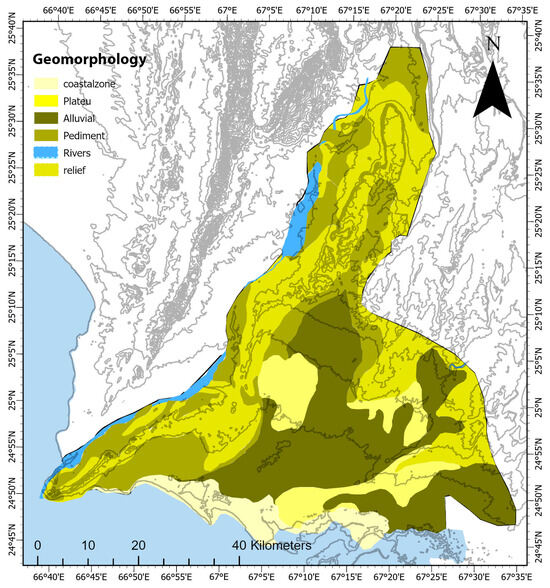
Figure 7.
Geomorphological map of Karachi (darkest color showing the highest GWR suitability landform).
Various land covers have shown different affinities for surface runoff and subsurface flows [59]. From a land use point of view, the old metropolitan areas are the densest, with intermixed residential and commercial settings. Notably, these areas usually lack formal green spaces. However, planned developments have parks and open spaces. These parks are fragmented throughout the developed urban areas, primarily planted with low-maintenance exotic vegetation. Other than parks, agricultural belts, mangrove swamps, and bare rangelands or sparse vegetation on the outskirts of metropolitan areas represent the major vegetation types. Contemporary real estate developments are emerging on the outskirts of formal rural agricultural lands or rangelands. Green and open spaces in the city are under constant pressure from significant encroachments and human activities [51]. This decreases the GWR potential of the open areas of Karachi (Figure 8).
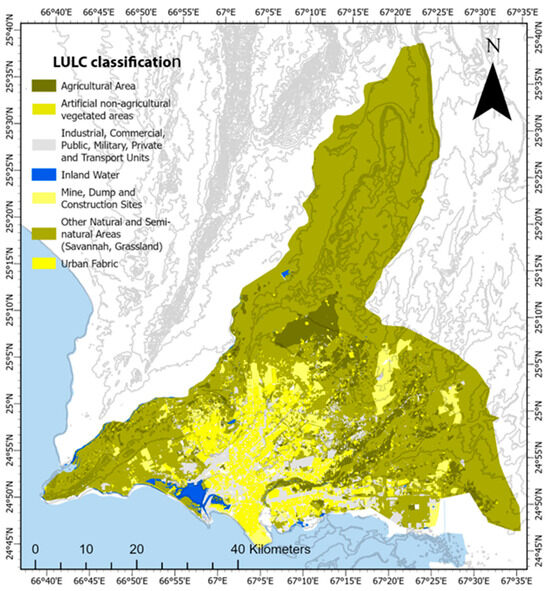
Figure 8.
LULC classification of Karachi (darkest color showing the highest GWR suitability land use).
An urban fabric with impervious surfaces causes more surface runoff and is least suitable for GWR [60]. Hence, though the dense urban tissue of the historical Karachi city shows high suitability for GWR in geomorphology, soil typology, and lithology layers, the built urban layer shows low GWR suitability (Figure 7, Figure 8 and Figure 9). Karachi combines Quaternary, Neogene, and Paleocene lithological formations from a geological perspective. Layers of Quaternary sediments mainly include alluvial deposits in the river valleys with high water holding capacity and recharge potential. Neogene sedimentary rocks contain clay, sandstone, and limestone, while Paleogene rocks mostly comprise limestone, clay, and sandstone with minor sandy clay [47] (Figure 9). Structurally, the region forms part of the Kirthar Fold Belt of the lower Indus basin and presents a series of plunging folds trending NE–SW [56]. These folds and lineaments provide water infiltration opportunities and are favorable for GWR (Figure 10).
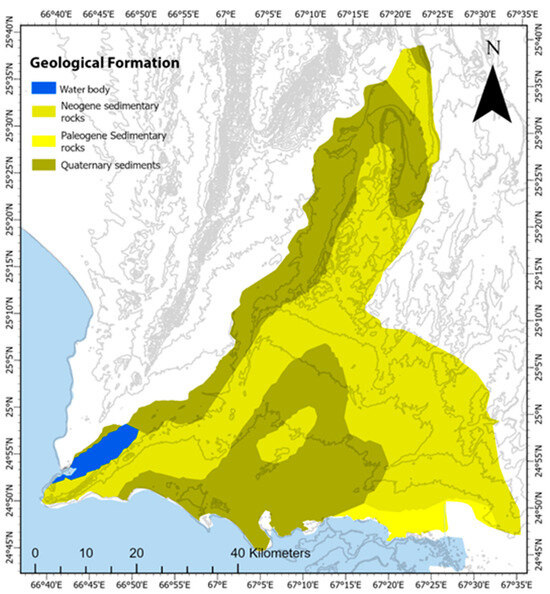
Figure 9.
Geological formation of Karachi (dark color showing the fragmented structure more suitable for GWR).

Figure 10.
Lineament density map of Karachi (more fractured areas in dark color as they allow more GWR).
From north to south, Karachi exhibits a decrease in slope. Most of the study area has very low slopes (0–12 degrees) and is suitable for GWR since this gives water more time to infiltrate. However, a high topographic gradient is present in the Northern Kirthar Natural Reserve Area and the southern Kohistan hills (Figure 11).
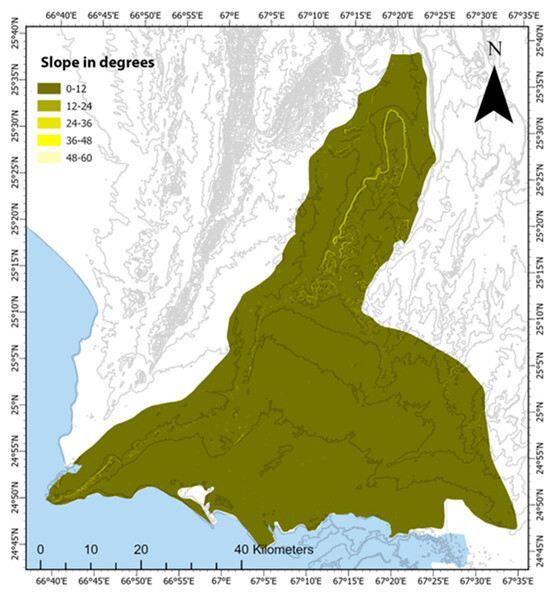
Figure 11.
Slope map of Karachi (low gradient area in dark color shows more affinity with GWR).
The Hub, Lyari, and Malir rivers and their surrounding river valleys have high drainage density when compared to the inland areas. High drainage density is associated with low GWR potential due to high flow velocity. Hence, there is a need to develop flow-delaying strategies along the river corridors (Figure 12). The Malir and Lyari rivers recharge the coastal aquifers, and the Hub River recharges aquifers of the Nari (Oligocene) and Gaj (Miocene) formations [61]. Rainfall is one of the most important sources of natural GWR since it facilitates high infiltration. Being in an arid region, Karachi experiences scarce and uneven rainfall, with a maximum of 240 mm in the Gadap area (Figure 13). Two types of loamy soils are present in Karachi: Lithosols and Calcic Yermosols. Since both soils favor water infiltration, slope differences can be used to assign suitable ranks (Figure 14) [47].
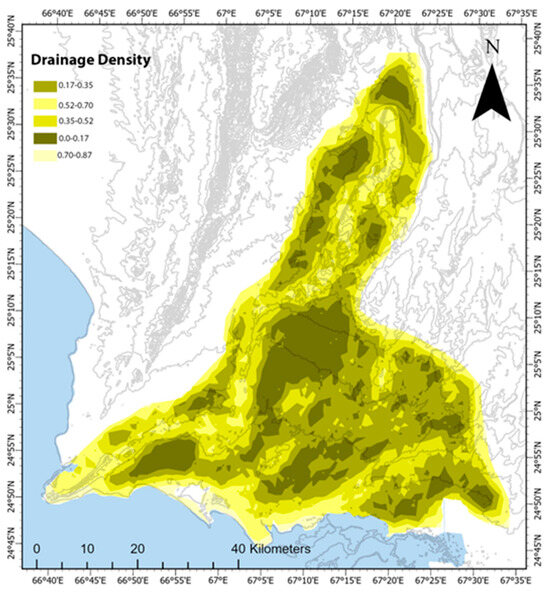
Figure 12.
Drainage density map of Karachi (areas with low flow velocity offer more GWR shown in dark color).
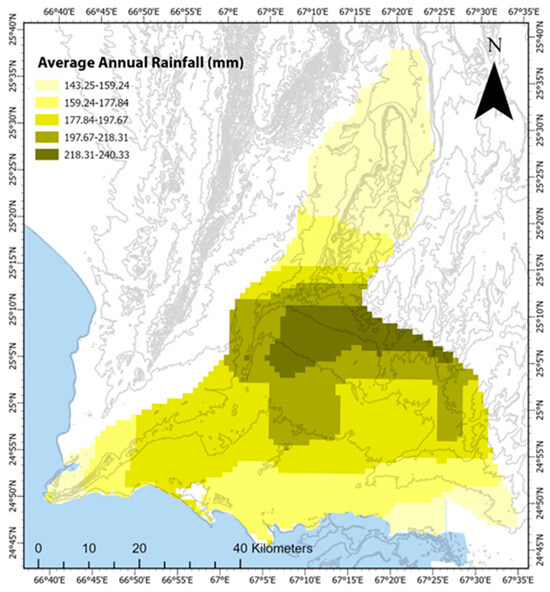
Figure 13.
Rainfall map of Karachi (darker areas have more frequent rainfall and high GWR potential).
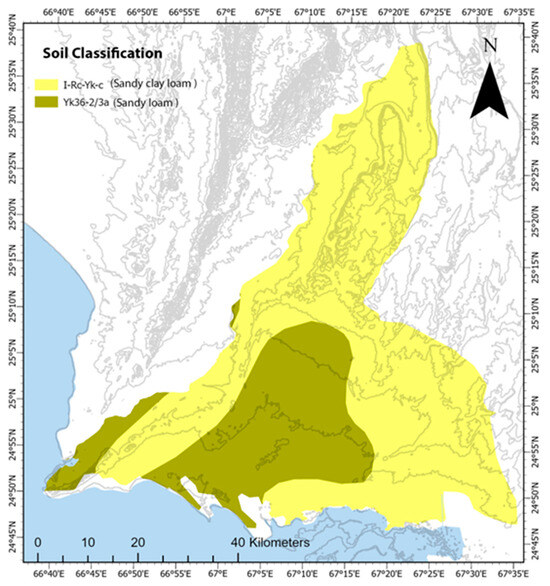
Figure 14.
Soil classification map of Karachi (more permeable soils allow more GWR).
3.2. Landscape Composites
A comparison between the natural landscape GWR potential map and the urban composite GWR potential map helps to understand the natural potential and anthropogenic impact on the GWR potential. Results demonstrate that areas with high and medium GWR potential have decreased in their GWR potential because of urban development, especially in the alluvial river valleys (Figure 15). Despite sub-surface geological conditions, GW levels have declined at alarming rates because of urbanization impacts [45]. Thus, the current urban sprawl harms the GWR potential and calls for long-term sustainable planning goals that protect both the groundwater and urban landscape.
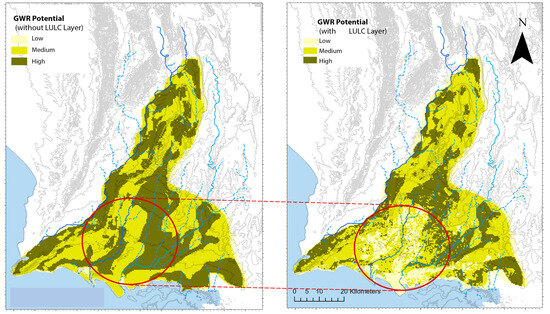
Figure 15.
Left—Natural landscape composite of GWR. Right—Urban landscape composite of GWR. Red areas highlight the areas where GWR has been significantly decreased because of urban land use despite favorable geological and sub-surface hydrological conditions.
3.3. Landscape-Based GWR for Karachi—An Application Perspective
A prerequisite for landscape-based GWR application is to ensure its adequate consideration in land use planning [34]. It helps us understand the interaction between the landscape, groundwater recharge (GWR), and the role of design in improving this relationship and encourages social–ecological inclusivity. It also allows for the envisioning of spatial GWR strategies relevant to different landscapes or spatial typologies. Hence, as a landscape-based approach, applying spatial strategies to facilitate groundwater recharge in a socially and ecologically inclusive way, corresponding to geological and hydrological contexts, can help achieve a multiscale vision on a regional and local scale [23].
Layering the urban landscape in terms of different landscape typologies with GWR potential can help to determine relevant GWR techniques suitable for their physical and social context (Figure 16). Significant typologies can be natural reserves (Kirthar National Park), river valleys (Lyari, Malir, Hub), urban cores (congested historic area, new developments), rural hinterlands, agricultural areas, and coastal areas (Port, fishermen villages, mangroves) [62]. It also offers design solutions to improve the degrading landscape conditions and guide future development while restoring ground hydrology.
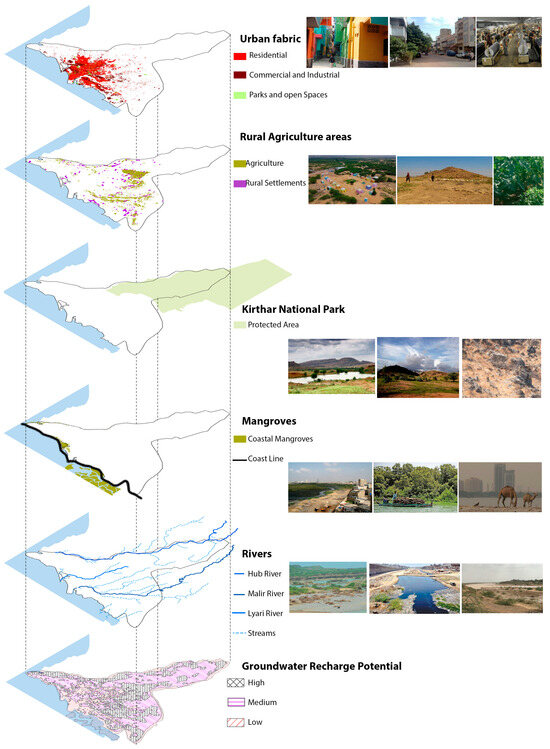
Figure 16.
Interconnecting GWR potential and different landscape typologies as a way to address urban landscape, future urban growth, and water challenges, and the application of landscape-based GWR.
4. Discussion
4.1. Reflection
Analysis of GWR potential along with the urban landscape suggests that higher GWR areas exist in the robust landscape structures of agriculture, and Kirthar Reserve underscores the possibility of positioning landscape-based GWR as the base for the improvement of existing and future urban development, as well as the enhancement of ecological and social services (Figure 16). Moreover, the reduced GWR potential areas in the urban core emphasize the need to rethink the existing urban landscape conditions and improve the quality of the urban landscape (Figure 15). Hence, framing the water resource issue as a landscape issue can be a new approach to managing the urban landscape conditions and resources. The interdisciplinary workshops conducted in Karachi also validated this holistic approach to address these intertwined challenges and to reflect on the possible potentials and challenges in the implementation of landscape-based GWR. Moreover, landscape-based GWR can serve as a radical and future-oriented holistic approach to target multiple benefits in uncertain and low-resource conditions [63].
4.2. Way Forward
4.2.1. Landscape-Based GWR as a Holistic Spatial Approach for Sustainable Regional Development
Though a network of solutions is needed for megacities like Karachi to restore the hydraulic cycle (i.e., water conservation, stormwater management, infrastructure improvements, and GWR), landscape-based GWR is one of the integral solutions that can work long-term on different levels in a socially and ecologically inclusive way by improving the existing urban landscape and guiding future urban development at various scales with the involvement of multiple stakeholders. The involvement of spatial expertise in maintaining groundwater resources provides an understanding of the operation of an area as a combination of different natural and urban systems working on multiple scales. Also, it helps to derive comprehensive insights from historical, socio-cultural, and ecological structures and promotes a holistic approach toward sustainable development [64].
Furthermore, the co-creative design process helps spatially visualize potential futures and bridges the gap between theory and practice across disciplines. By designing adaptable, multifunctional spatial strategies, planners can accommodate shifting priorities, whether due to climate change, urbanization, cultural norms, or policy changes [10]. In this way, landscape-based GWR integrates with broader ecological, aesthetic, and recreational goals [23].
4.2.2. Landscape-Based GWR as a Way Toward Interdisciplinary Collaboration
Currently, the major stakeholders in water management in Karachi include KWSB, universities, the Sindh government, community representatives, NGOs, and experts [65]. From a participatory perspective, landscape-based GWR further expands to engage local communities, urban planning professionals, landscape designers, architects, social scientists, geologists, and real estate professionals as stakeholders. This integration of stakeholders allows for both top-down (expert-driven) and bottom-up (community-driven) approaches, which are vital for resolving conflicts and improving sustainable groundwater management at different (local and regional) levels [66]. A shared understanding of the importance of GWR for restoring the hydrological and ecological balance of cities promotes interdisciplinary capacity building, the exchange of ideas, and the creation of knowledge-sharing forums.
4.2.3. Landscape-Based GWR as a Tool of Awareness and Empowerment
Karachi city has suitable surface and sub-surface landscape conditions for GWR, but a lack of futuristic and holistic vision hinders the systematic integration of GWR in the urban landscape [45]. Various local studies have pointed out a high dependence on groundwater in daily life. A study done on the SITE (subdivision of Karachi) showed that reliance on groundwater is almost 94%. GW levels in industrial sites are depleting more alarmingly than in residential areas [3]. Despite the high reliance on groundwater, the bulk water supply for Karachi has been prioritized by policy-making institutions.
Negligence toward this valuable resource has deteriorated its quality and quantity. Groundwater resources are poorly maintained and contaminated by sewerage discharge, which flows parallel to drinking and household water [67]. Using landscape-based strategies (i.e., use of halophytes, constructed wetlands, sand filtration) managed by local stakeholders can improve the water quality to make it suitable for crop cultivation and other raw uses.
By integrating landscape-based GWR strategies through collaborations and participatory methods, we can create awareness about the importance of this valuable resource. This approach can also reduce reliance on the water tanker supply system, which is causing huge social injustice and exploiting lower-income groups. Moreover, public-private partnerships can play a vital role in basic infrastructure improvement to enhance the impact of landscape-based GWR application.
4.2.4. Learning from the Relevant Contexts and Developing Adaptable Strategies
Landscape-based GWR supports the incremental approach to acquiring contextual knowledge about landscape systems that can be revised, adjusted, and implemented based on state-of-the-art documentation and in other relevant contexts. It encourages learning from the relevant contexts and examples. In this way, it can help develop multi-scale spatial integration of adaptable strategies. For example, the Water Cup initiative by Paani Foundation India [68], the Wadi Hanifa Rehabilitation Project in KSA [69], and the restoration of the Loess Plateau in China [70] are regional-scale precedents that encouraged the involvement of local communities by creating awareness and incentives to develop community-based models that add social, ecological, and economic value to GWR.
Moreover, landscape-based groundwater recharge values local initiatives and provides an opportunity to develop a series of networks of systematic interventions. Local projects like the revitalization of streets in the historic core of Karachi [71] and neighborhood-scale urban forests [72] can serve as local case studies of landscape-based GWR.
4.3. Limitations and Future Research Directions
This study was limited to using open data and the limited quantitative documentation of groundwater levels for Karachi city. Also, our main focus was on drawing logical observations and developing a holistic understanding of the landscape and spatial planning. However, we strongly recommend quantitative documentation, updated hydrological modeling, revised population statistics, and urban sprawl mapping to validate the results through surveying and remote sensing technologies. This can also bridge the communication gap between sectors and provide a knowledge base for future research. Also, future research should develop a detailed design toolbox of landscape-based GWR strategies suitable for different spatial landscape typologies of Karachi city and their validation with local stakeholders (for local implementation) and international stakeholders (to reflect on their adaptive value and make them relevant for other contexts). Developing the participatory framework to show the social–ecological inclusiveness of this approach can be another possible dimension in future research.
5. Conclusions
This paper presents the holistic approach of landscape-based groundwater recharge (GWR) as a way toward sustainable development. This approach is based on an understanding of the urban landscape as a system and its role in reactivating the GWR potential of an area by using socially and ecologically inclusive spatial strategies. Groundwater recharge techniques, landscape, and knowledge-based design are the core components of this approach.
We took the megacity of Karachi as a case study to develop the “landscape-based groundwater recharge” approach. We modified the GWR potential map of Karachi by adding the geomorphological layer to better understand the impact of different landforms on GWR. Also, we compared GWR potential maps with and without the urban landscape layer, which showed a significant decrease in natural GWR potential, especially in densely populated alluvial river valleys. This baseline mapping also highlighted the need for a spatial planning perspective to improve the GWR potential through the natural and urban landscape and vice versa.
Understanding the landscape (biophysical and social context) of different spatial typologies of Karachi city also resulted in the development of a vision to improve the existing landscape conditions of the city and to guide future development by considering the landscape and groundwater recharge as a basis for design and planning. For example, improving river corridors and streetscapes in dense urban areas, improving ecosystem services of reserves in the Kirthar reserve, and safeguarding rural agriculture and orchards in the rural hinterland of Karachi city. Applying this approach in Karachi can also make the Indus water supply less stressed while improving the city’s urban quality of life and landscape.
This study used government reports, surveys, maps, archives, workshops, and pre-partition literature as evidence to support landscape-based GWR development in Karachi. Interdisciplinary collaboration has been highlighted as an essential tool for formulating a contextual yet adaptive spatial framework for integrating landscape-based GWR in the sustainable urban development of Karachi city. We strongly recommend extensive surveying and mapping of the existing aquifer levels and urban growth to more precisely measure the impacts of landscape-based GWR and enrich our understanding of—and relationship with—ground hydrological conditions and the urban landscape. Also, exploring design and participation strategies can be a possible future research direction.
Supplementary Materials
The following supporting information can be downloaded at: https://www.mdpi.com/article/10.3390/su17114931/s1.
Author Contributions
A.R.: conceptualization, methodology, software, investigation, writing—original draft preparation, AHP process, visualization. S.N.: supervision, writing—review and editing, validation. I.B.: supervision, writing—review and editing, validation. All authors have read and agreed to the published version of the manuscript.
Funding
This research is funded by Chief Minister Merit Scholarship, Punjab Educational Endowment Fund, Pakistan.
Data Availability Statement
The original contributions presented in the study are already included in the review. Further data inquiries can be directed to the corresponding author.
Acknowledgments
We would like to thank Ibtihaj Ahmad (University of Nevada, Las Vegas) for his guidance during the initial phase of this research and also for sharing the datasets that were used in the validation of the AHP process.
Conflicts of Interest
The authors declare no conflicts of interest. The funding sponsors had no role in the choice of research project, study design, collection, analysis, interpretation of data, manuscript writing, or the decision to publish the results.
References
- Van den Brandeler, F.; Gupta, J.; Hordijk, M. Megacities and rivers: Scalar mismatches between urban water management and river basin management. J. Hydrol. 2019, 573, 1067–1074. [Google Scholar] [CrossRef]
- Braga, A.C.R.; Serrao-Neumann, S.; de Oliveira Galvão, C. Groundwater Management in Coastal Areas through Landscape Scale Planning: A Systematic Literature Review. Environ. Manag. 2020, 65, 321–333. [Google Scholar] [CrossRef] [PubMed]
- Sohail, M.T.; Hussan, A.; Ehsan, M.; Al-Ansari, N.; Akhter, M.M.; Manzoor, Z.; Elbeltagi, A. Groundwater budgeting of Nari and Gaj formations and groundwater mapping of Karachi, Pakistan. Appl. Water Sci. 2022, 12, 267. [Google Scholar] [CrossRef]
- Chen, Y.; Li, Z.; Fan, Y.; Wang, H.; Deng, H. Progress and prospects of climate change impacts on hydrology in the arid region of northwest China. Environ. Res. 2015, 139, 11–19. [Google Scholar] [CrossRef]
- Swapan, M.S.H.; Zaman, A.U.; Ahsan, T.; Ahmed, F. Transforming Urban Dichotomies and Challenges of South Asian Megacities: Rethinking Sustainable Growth of Dhaka, Bangladesh. Urban Sci. 2017, 1, 31. [Google Scholar] [CrossRef]
- Backhaus, A.; Fryd, O.; Dam, T. Research in landscape architecture_methods and methodology. In Research in Landscape Architecture_Methods and Methodology; Van den Brink, A., Bruns, D., Tobi, H., Bell, S., Eds.; Routledge: London, UK, 2017; pp. 285–304. [Google Scholar]
- Kumar, A.; Button, C.; Gupta, S.; Amezaga, J. Water Sensitive Planning for the Cities in the Global South. Water 2023, 15, 235. [Google Scholar] [CrossRef]
- Stokman, A. Water Purificative Landscapes-Constructed Ecologies and Contemporary Urbanism. In Proceedings of the 45th World Congress of the International Federation of Landscape Architects IFLA 2008, Utrecht, The Netherlands, 30 June–3 July 2008; pp. 51–61. [Google Scholar]
- Leonard, L.S. Assessment of groundwater quality along cemeteries and associated potential health concerns in Dar es Salaam, Tanzania. Water Pract. Technol. 2022, 17, 1218–1229. [Google Scholar] [CrossRef]
- Riaz, A.; Nijhuis, S.; Bobbink, I. The Role of Spatial Planning in Landscape-Based Groundwater Recharge: A Systematic Literature Review. Water 2025, 17, 862. [Google Scholar] [CrossRef]
- Bera, K.; Newcomer, M.E.; Banik, P. Groundwater recharge site suitability analysis through multi-influencing factors (MIF) in West Bengal dry-land areas, West Bengal, India. Acta Geochim. 2022, 41, 1030–1048. [Google Scholar] [CrossRef]
- Algaydi, B.A.; Subyani, A.M.; Hamza, M.H. Investigation of Groundwater Potential Zones in Hard Rock Terrain, Wadi Na’man, Saudi Arabia. Groundwater 2019, 57, 940–950. [Google Scholar] [CrossRef]
- Negash, T.W.; Abagale, F.K.; Baatuuwie, B.N. Impact of land-use and land-cover change on watershed hydrology: A case study of Mojo watershed, Ethiopia. Environ. Earth Sci. 2022, 81, 536. [Google Scholar] [CrossRef]
- Shrestha, S.; Pandey, V.P. Groundwater as an Environmental Issue in Asian Cities. In Groundwater Environment in Asian Cities: Concepts, Methods and Case Studies; Elsevier Inc.: Amsterdam, The Netherlands, 2016; pp. 1–13. [Google Scholar] [CrossRef]
- Fang, X.; Ma, Q.; Liu, Z.; Wu, J. Landscape sustainability and land sustainability: A bibliometric analysis. Land Use Policy 2024, 147, 107374. [Google Scholar] [CrossRef]
- Lerner, D.N.; Harris, B. The relationship between land use and groundwater resources and quality. Land Use Policy 2009, 26 (Suppl. 1), S265–S273. [Google Scholar] [CrossRef]
- Baškarada, S. Qualitative Case Study Guidelines. Qual. Rep. 2014, 19, 1–25. [Google Scholar] [CrossRef]
- Minh, D.T. Criteria Affecting Groundwater Potential: A Systematic Review of Literature. In Environmental Science and Engineering; Springer Science and Business Media Deutschland GmbH: Berlin/Heidelberg, Germany, 2023; pp. 85–110. [Google Scholar] [CrossRef]
- Scanlon, B.R.; Jolly, I.; Sophocleous, M.; Zhang, L. Global impacts of conversions from natural to agricultural ecosystems on water resources: Quantity versus quality. Water Resour. Res. 2007, 43. [Google Scholar] [CrossRef]
- de Vries, J.J.; Simmers, I. Groundwater recharge: An overview of processes and challenges. Hydrogeol. J. 2002, 10, 5–17. [Google Scholar] [CrossRef]
- Alley, W.; Dillon, P.; Zheng, Y. Basic Concepts of Managed Aquifer Recharge, in Managed Aquifer Recharge: Overview and Governance; IAH Special Publication: Reading, UK, 2022; ISBN 978-1-3999-2814-4. [Google Scholar]
- Bürgi, M.; Ali, P.; Chowdhury, A.; Heinimann, A.; Hett, C.; Kienast, F.; Mondal, M.K.; Upreti, B.R.; Verburg, P.H. Integrated Landscape Approach: Closing the Gap between Theory and Application. Sustainability 2017, 9, 1371. [Google Scholar] [CrossRef]
- Nijhuis, S. Landscape-Based Urbanism: Cultivating Urban Landscapes Through Design. In Contemporary Urban Design Thinking; Springer Nature: Berlin/Heidelberg, Germany, 2022; Volume Part F7, pp. 249–277. [Google Scholar] [CrossRef]
- Soini, K.; Vaarala, H.; Pouta, E. Residents’ sense of place and landscape perceptions at the rural–urban interface. Landsc. Urban Plan. 2012, 104, 124–134. [Google Scholar] [CrossRef]
- McHarg, I.L. Design with Nature; Natural History Press: Philadelphia, PA, USA, 1969; Available online: https://archive.org/details/designwithnature00mcha/mode/2up (accessed on 16 January 2024).
- DeFries, R.; Rosenzweig, C. Toward a whole-landscape approach for sustainable land use in the tropics. Proc. Natl. Acad. Sci. USA 2010, 107, 19627–19632. [Google Scholar] [CrossRef]
- Arts, B.; Buizer, M.; Horlings, L.; Ingram, V.; Van Oosten, C.; Opdam, P. Annual Review of Environment and Resources Landscape Approaches: A State-of-the-Art Review Keywords. Annu. Rev. Environ. Resour. 2017, 8, 439–463. [Google Scholar] [CrossRef]
- Klaasen, I.T. Knowledge-Based Design: Developing Urban & Regional Design into a Science; Delft University of Technology: Delft, The Netherlands, 2003. [Google Scholar]
- Jam, A.S.; Mosaffaie, J. Introducing the concept of a ladder of watershed management: A stimulus to promote watershed management approaches. Environ. Sci. Policy 2023, 147, 315–325. [Google Scholar] [CrossRef]
- Ebregt, A.; De Greve, P. Buffer Zones and Their Management Policy and Best Practices for Terrestrial Ecosystems in Developing Countries Theme Studies Series 5 Forests, Forestry and Biological Diversity Support Group. 2000. Available online: www.minlnv.nl (accessed on 15 April 2025).
- United Nations. Transforming Our World: The 2030 Agenda for Sustainable Development; United Nations: New York, NY, USA, 2015. [Google Scholar]
- Nijhuis, S. Landscape Logic; Jap Sam Books: Prinsenbeek, The Netherlands, 2024; Available online: https://www.openaccess.nl/en/you-share-we-take-care (accessed on 29 March 2025).
- Groat, L.; Wang, D. Architectural Research Methods; Wiley: Hoboken, NJ, USA, 2013. [Google Scholar]
- Huan, Y.; Nijhuis, S.; Tillie, N. Urban agriculture as a landscape approach for sustainable urban planning. An example of Songzhuang, Beijing. Front. Sustain. 2024, 5, 1330292. [Google Scholar] [CrossRef]
- Qureshi, S. The fast growing megacity Karachi as a frontier of environmental challenges: Urbanization and contemporary urbanism issues. J. Geogr. Reg. Plan. 2010, 3, 306–321. Available online: http://www.academicjournals.org/JGRP (accessed on 5 January 2025).
- Niazi, F.; Azad, A.P. Investigation of Ethnic Diversity In Pakistan: A Case Study of Karachi. J. Basic Appl. Sci. 2018, 14, 246–253. [Google Scholar] [CrossRef]
- Aslam, R.W.; Shu, H.; Yaseen, A. Monitoring the population change and urban growth of four major Pakistan cities through spatial analysis of open source data. Ann. GIS 2023, 29, 355–367. [Google Scholar] [CrossRef]
- Al-Kindi, K.M.; Alqurashi, A.F.; Al-Ghafri, A.; Power, D. Assessing the Impact of Land Use and Land Cover Changes on Aflaj Systems over a 36-Year Period. Remote Sens. 2023, 15, 1787. [Google Scholar] [CrossRef]
- Vaddiraju, S.C.; Reshma, T. Urbanization implications on hydro-meteorological parameters of Saroor Nagar Watershed of Telangana. Environ. Chall. 2022, 8, 100562. [Google Scholar] [CrossRef]
- Randhir, T.O.; Tsvetkova, O. Spatiotemporal dynamics of landscape pattern and hydrologic process in watershed systems. J. Hydrol. 2011, 404, 1–12. [Google Scholar] [CrossRef]
- Ramli, I.; Achmad, A.; Anhar, A.; Izzaty, A. Landscape patterns changes and relation to water infiltration of Krueng Peusangan Watershed in Aceh. In IOP Conference Series: Earth and Environmental Science; IOP Publishing Ltd.: Bristol, UK, 2021. [Google Scholar] [CrossRef]
- Bhaskar, A.S.; Beesley, L.; Burns, M.J.; Fletcher, T.D.; Hamel, P.; Oldham, C.E.; Roy, A.H. Will it rise or will it fall? Managing the complex effects of urbanization on base flow. Freshw. Sci. 2016, 35, 293–310. [Google Scholar] [CrossRef]
- Tayyab, M. Management of Surface Water Resources to Mitigate the Water Stress in Karachi. In International Conference on Hydrology and Water Resources; University of Engineering and Technology: Lahore, Pakistan, 2021; pp. 196–204. Available online: www.cewre.edu.pk (accessed on 25 December 2024).
- City District Government Karachi; Engineering Consultants International (Pvt.) Limited; PADCO-AECOM. Karachi Strategic Development Plan 2020. 2007. Available online: https://urckarachi.org/2020/07/19/karachi-strategic-development-plan-2020/ (accessed on 27 February 2024).
- Irfan, M.; Kazmi, S.J.H.; Arsalan, M.H. Sustainable harnessing of the surface water resources for Karachi: A geographic review. Arab. J. Geosci. 2018, 11, 24. [Google Scholar] [CrossRef]
- WWF. Situational Analysis of Water Resources of Karachi. Karachi. 2019. Available online: https://wwfasia.awsassets.panda.org/downloads/report___situational_analysis_of_water_resources_of_karachi.pdf (accessed on 27 February 2024).
- Ahmad, I.; Hasan, H.; Jilani, M.M.; Ahmed, S.I. Mapping potential groundwater accumulation zones for Karachi city using GIS and AHP techniques. Environ. Monit. Assess. 2023, 195, 381. [Google Scholar] [CrossRef]
- Pithawala, M.; Kaye, P.; Wadia, D. Topography and Hydrography. In Geology and Geography of Karachi and Its Neighborhood; Daily Gazette Press: Karachi, Pakistan, 1946; pp. 14–17. [Google Scholar]
- Lari, Y.; Lari, M.S. The Dual City: Karachi During the Raj; Heritage Foundation; Oxford University Press: Karachi, Pakistan, 1996. [Google Scholar]
- Hasan, A.; Mohib, M. Reporting on ‘slums’ in selected cities A Case Study of Karachi, Pakistan; 2002. Available online: http://arifhasan.org/wp-content/uploads/2002/06/AH84-Reporting_on_slums.pdf (accessed on 26 May 2025).
- Qureshi, S.; Breuste, J.H.; Lindley, S.J. Green Space Functionality Along an Urban Gradient in Karachi, Pakistan: A Socio-Ecological Study. Hum. Ecol. 2010, 38, 283–294. [Google Scholar] [CrossRef]
- Nergis, Y.; Sharif, M.; Choudhry, A.F.; Hussain, A.; Butt, J.A. Impact of industrial and sewage effluents on Karachi coastal water and sediment quality. Middle East J. Sci. Res. 2012, 11, 1443–1454. [Google Scholar] [CrossRef]
- Anwar, F. People and the Land: Empowering Communities for Social Justice: Rural Karachi—A Case Study; Shehri-Citizens for a Better Environment: Karachi, Pakistan, 2012. [Google Scholar]
- Hasan, A. Emerging Urbanisation Trends: The Case of Karachi; IGC: London, UK, 2016. [Google Scholar]
- Nijhuis, S.; Xiong, L.; Cannatella, D. Towards a Landscape-based Regional Design Approach for Adaptive Transformation in Urbanizing Deltas. Res. Urban. Ser. 2021, 6, 55–80. [Google Scholar] [CrossRef]
- Hamid, G.; Mallick, K.A.; Bilal, M.; Azma, I.; Zohra, S.Z.I.R. Geomorphology of Karachi with a brief note on its Vegetation. Int. J. Biol. Biotechnol. 2012, 9, 123–137. [Google Scholar]
- Das, M.; Parveen, T.; Ghosh, D.; Alam, J. Assessing groundwater status and human perception in drought-prone areas: A case of Bankura-I and Bankura-II blocks, West Bengal (India). Environ. Earth Sci. 2021, 80, 636. [Google Scholar] [CrossRef] [PubMed]
- Díaz-Alcaide, S.; Martínez-Santos, P. Review: Advances in groundwater potential mapping. Hydrogeol. J. 2019, 27, 2307–2324. [Google Scholar] [CrossRef]
- Arulbalaji, P.; Padmalal, D.; Sreelash, K. GIS and AHP Techniques Based Delineation of Groundwater Potential Zones: A case study from Southern Western Ghats, India. Sci. Rep. 2019, 9, 2082. [Google Scholar] [CrossRef]
- Li, R.; Zhu, G.; Lu, S.; Sang, L.; Meng, G.; Chen, L.; Jiao, Y.; Wang, Q. Effects of urbanization on the water cycle in the Shiyang River basin: Based on a stable isotope method. Hydrol. Earth Syst. Sci. 2023, 27, 4437–4452. [Google Scholar] [CrossRef]
- Humza, M.; Waris, M.; Haris, M. Aggregate Properties Of Fluvial Deposits Of Malir, Lyari And Hub Rivers Of Karachi Embayment, Southern Indus Basin, Pakistan. Int. J. Sci. Res. Publ. (IJSRP) 2022, 12, 42–57. [Google Scholar] [CrossRef]
- Asim, R. Landscape-Based Groundwater Recharge Scenarios: A Two-Day Joint Workshop of TU Delft, The Netherlands and NED University, Pakistan; ARCHI TIMES: Karachi, Pakistan, 2025; pp. 6–7. [Google Scholar]
- Vogelsang, L.G.; Weikard, H.-P.; van Loon-Steensma, J.M.; Bednar-Friedl, B. Assessing the cost-effectiveness of Nature-based Solutions under climate change uncertainty and learning. Water Resour. Econ. 2023, 43, 100224. [Google Scholar] [CrossRef]
- Kmoch, L.; Bou-Lahriss, A.; Plieninger, T. Drought threatens agroforestry landscapes and dryland livelihoods in a North African hotspot of environmental change. Landsc. Urban Plan. 2024, 245, 105022. [Google Scholar] [CrossRef]
- Ahmed, N.; Sohail, M. Stakeholders’ response to the private sector participation of water supply utility in Karachi, Pakistan. Water Policy 2004, 6, 229–247. [Google Scholar] [CrossRef][Green Version]
- Vejre, H.; Vesterager, J.P.; Kristensen, L.S.; Primdahl, J. Stakeholder and expert-guided scenarios for agriculture and landscape development in a groundwater protection area. J. Environ. Plan. Manag. 2011, 54, 1169–1187. [Google Scholar] [CrossRef]
- Khan, M.K.; Ayoub, W.; Saied, S.; Hussain, M.M.; Masood, S.S.; Siddique, A.; Khwaja, H.A. Statistical and Geospatial Assessment of Groundwater Quality in the Megacity of Karachi. J. Water Resour. Prot. 2019, 11, 311–332. [Google Scholar] [CrossRef]
- Satyamev Jayate Water Cup: Overview, Impact and Success Stories|Paani Foundation. Available online: https://www.paanifoundation.in/satyamev-jayate-water-cup/ (accessed on 23 May 2025).
- Moosavi, S. Time, trial and thresholds: Unfolding the iterative nature of design in a dryland river rehabilitation. J. Landsc. Arch. 2018, 13, 22–35. [Google Scholar] [CrossRef]
- Yu, Y.; Zhao, W.; Martinez-Murillo, J.F.; Pereira, P. Loess Plateau: From degradation to restoration. Sci. Total Environ. 2020, 738, 140206. [Google Scholar] [CrossRef]
- One Planet. Denso Hall Rahguzar Walking Street for Regeneration of Karachi’s Historic Core: A Case of Circular Economy COVID-19 Recovery Strategy. Available online: https://www.oneplanetnetwork.org/knowledge-centre/resources/denso-hall-rahguzar-walking-street-regeneration-karachis-historic-core (accessed on 14 May 2025).
- Qureshi, S. Clifton Urban Forest: A Game-Changing Green Lung in the Center of Karachi. Available online: https://www.sugiproject.com/forests/clifton-urban-forest (accessed on 14 January 2025).
Disclaimer/Publisher’s Note: The statements, opinions and data contained in all publications are solely those of the individual author(s) and contributor(s) and not of MDPI and/or the editor(s). MDPI and/or the editor(s) disclaim responsibility for any injury to people or property resulting from any ideas, methods, instructions or products referred to in the content. |
© 2025 by the authors. Licensee MDPI, Basel, Switzerland. This article is an open access article distributed under the terms and conditions of the Creative Commons Attribution (CC BY) license (https://creativecommons.org/licenses/by/4.0/).
